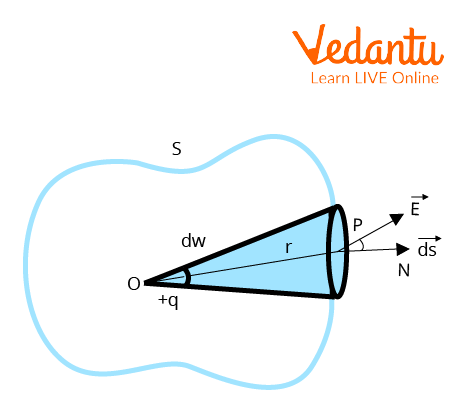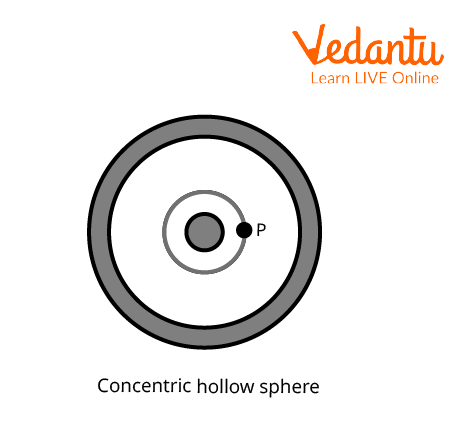




How Does Gauss Theorem Apply to Electric and Gravitational Fields?
Explore the essentials of Gauss Theorem, an important principle in electrostatics and vector calculus, unlocking its definition, formulas, proof, and real-life applications with simple examples. Whether you're preparing for Class 12 board exams or want to master Gauss divergence theorem concepts, this page provides clear explanations and step-by-step solutions to boost your Physics understanding.
Understanding Gauss Theorem: Concept and Practical Examples
Gauss Theorem—also called Gauss’s law or Gauss divergence theorem—establishes a powerful relationship between the electric flux passing through a closed surface and the net charge enclosed within that surface. In electrostatics, this law is used extensively to determine the electric field generated by symmetric charge distributions, making it a fundamental tool for Physics and Mathematics, especially in Gauss theorem Maths and Gauss theorem Calculus.
Imagine a positive or negative electric charge. It sets up an electric field, or “energy tube,” around itself. The measure of the field “flowing” through a surface, known as electric flux, depends directly on the amount of charge within that surface. Carl Friedrich Gauss formalized this observation into the theorem that carries his name and is foundational for Class 12 Physics, competitive exams, and higher mathematics.

While Joseph-Louis Lagrange first introduced similar principles, Carl Friedrich Gauss extended them and formulated what we now know as Gauss Theorem. Gauss’s contributions are celebrated not only in Physics but also in areas like number theory (see: gauss theorem number theory) and differential geometry (gauss theorem egregium).
Statement and Key Formulas of Gauss Theorem
The core statement of Gauss Theorem (Gauss law in electrostatics) is:
- The total electric flux through any closed surface is directly proportional to the total electric charge enclosed within that surface.
Expressed mathematically, the Gauss theorem formula is:
Where:
- $\phi$ is the electric flux through surface $S$
- $\vec{E}$ is the electric field vector
- $Q$ is the net electric charge enclosed
- $\varepsilon_{0}$ is the permittivity of free space (the electric constant)
This is not only a Physics result but also forms the basis for Gauss divergence theorem in vector calculus, connecting surface and volume integrals (see also Stokes' theorem for additional comparison).
Gauss Theorem Proof: Step-by-Step Derivation
To understand Gauss theorem proof, let's break the process into clear, logical steps. We'll consider a point charge inside a closed surface and calculate the total electric flux through that surface.

- Place a point charge $q$ at the center of a closed surface $S$.
- The electric field at a distance $r$ from the charge is: $E = \frac{1}{4\pi\varepsilon_{0}} \frac{q}{r^2}$
- For an infinitesimal area $ds$, flux $d\phi = E \cdot ds \cdot \cos \theta$
- Since $E$ is radial and $ds$ is normal to the surface, $\cos\theta = 1$
- Total flux: $\phi = \int_S E\, ds = E \int_S ds = E \cdot 4\pi r^2$
- Substitute the value of $E$:
- $\phi = \left(\frac{1}{4\pi\varepsilon_{0}} \frac{q}{r^2}\right) \cdot 4\pi r^2 = \frac{q}{\varepsilon_{0}}$
Thus, Gauss theorem is proved. This process is a textbook example of both Gauss theorem electric field application and understanding Gauss divergence theorem formula in vector terms. For more derivations, see our important Physics derivations resource.
Limitations and Conditions of Gauss Theorem
While Gauss Theorem and its application greatly simplify many Physics problems, there are essential limitations to keep in mind:
- It is best suited for symmetrical charge distributions (spherical, cylindrical, or planar symmetry).
- Applies only in electrostatics (stationary charges).
- The Gaussian surface must be chosen to match the distribution’s symmetry.
- Does not directly provide the force on a charge, only the relation between flux and total charge.
Gauss Theorem for gravitational field follows similar logic but is adapted to mass and gravity instead of charge and electric field.
Applications and Examples: Gauss Theorem in Real Physics Problems
Gauss Theorem is especially powerful when used for highly symmetric situations. Here are some classic use cases and solved examples:
- Calculating the electric field around an infinite line of charge (wire).
- Finding the field from an infinite charged sheet.
- Determining the electric field inside and outside spherical charge distributions.
- Comparing with Gauss law for magnetism (where the net magnetic flux through a closed surface is always zero).
Let’s work through a step-by-step Gauss theorem example to see the theorem in action.

Example 1: Electric Field at a Distance from a Point Charge
Problem: Find the electric field at a distance $r = 0.6\, \text{m}$ from a charge $Q = 0.2\, \text{C}$ distributed uniformly over a sphere.
Apply Gauss theorem formula:
Plug in the values:
- $Q = 0.2\, \text{C}$
- $r = 0.6\, \text{m}$
- $\varepsilon_{0} = 8.85 \times 10^{-12} \, \text{C}^2/\text{N} \cdot \text{m}^2$
Example 2: Field Due to an Infinite Plane Sheet
Problem: An infinite plane has a surface charge density $\sigma = 2.0 \times 10^{-6}\, \text{C}/\text{m}^2$. Find the electric field at a point whose position makes a $60^\circ$ angle with the Z-axis, using a circle of radius $1\,\text{cm}$ lying in the positive $x, y, z$ direction.
By Gauss law:
Flux through the circle:
Plug in the values. Using trigonometry and the provided data, the electric field magnitude becomes $17.5\, \text{Nm}^2\text{C}^{-1}$.
Example 3: Field Inside a Hollow Conducting Sphere
For a Gaussian surface entirely inside a hollow conductor, no charge is enclosed: $Q = 0$. Thus, $E = 0$ at every point inside the shell.
For sheets, wires, and spheres with uniform charge, Gauss theorem class 12 applications show that field can be calculated quickly by symmetry. For more in-depth explanations, visit our detailed breakdown of electric fields for spheres and the guide on infinite wire fields.
Summary Table: Common Gauss Theorem Formulas
| Situation | Formula | Notes |
|---|---|---|
| Point charge | $E = \dfrac{1}{4\pi\varepsilon_{0}} \dfrac{q}{r^2}$ | Radial symmetry |
| Infinite line charge | $E = \dfrac{\lambda}{2\pi r\varepsilon_{0}}$ | Cylindrical symmetry |
| Infinite plane sheet | $E = \dfrac{\sigma}{2\varepsilon_{0}}$ | Planar symmetry |
| Inside hollow conductor | $E = 0$ | No net enclosed charge |
Referencing these formulae helps solve quick Gauss theorem divergence cases or Gauss divergence theorem examples for board and competitive exams.
Conclusion: The Power of Gauss Theorem in Physics
Gauss Theorem is essential for relating electric flux to enclosed charge, vastly simplifying electric field calculations for symmetric charge setups. Its versatility links electrostatics, vector calculus, and even concepts like Gauss theorem for gravitational field. Mastering its formula, applications, and underlying logic is crucial for Physics students at every level. Continue your Physics journey with more concepts like Faraday's Law or explore mathematical links through vector analysis in Physics to strengthen your problem-solving skills.
FAQs on Understanding Gauss Theorem: Concepts, Uses & Examples
1. What is Gauss Theorem in physics?
Gauss Theorem, also called Gauss's Law, states that the total electric flux through a closed surface is equal to the net electric charge enclosed divided by the permittivity of free space (ε₀).
Key points:
- Mathematically: ∮E·dA = Qenclosed/ε₀
- Applies to symmetric charge distributions
- Essential for calculating electric fields in electromagnetics
2. State Gauss Theorem with formula.
Gauss Theorem states the relationship between electric flux and enclosed charge:
- The net electric flux through any closed surface equals 1/ε₀ times the total charge enclosed.
- Formula: ∮E·dA = Qenclosed/ε₀
3. What are the applications of Gauss Theorem?
Gauss Theorem is widely used to compute electric fields in situations with symmetry.
Applications include:
- Electric field due to a point charge
- Field near an infinite line of charge
- Field around an infinite plane sheet of charge
- Field inside and outside a charged conducting shell
4. Explain the significance of Gauss Theorem in electrostatics.
The significance of Gauss Theorem lies in simplifying complex calculations of electric fields for symmetrical charge distributions.
- Makes solving electrostatics problems easier
- Explains the behavior of conductors and insulators in electric fields
- Foundational for understanding Maxwell's equations
5. What are the main limitations of Gauss Theorem?
The main limitations of Gauss Theorem include:
- It is mainly useful for symmetric charge distributions like spheres, cylinders, and planes
- Does not easily apply to irregular shapes or non-uniform charge distributions
- Requires accurate knowledge of the net enclosed charge
6. What is the statement and mathematical form of Gauss’s law?
Gauss’s law states that the total electric flux through a closed surface is equal to the charge enclosed divided by the permittivity of free space.
Mathematical form:
- ∮E·dA = Qenclosed/ε₀
7. How is Gauss Theorem applied to find the electric field due to a uniformly charged sphere?
To calculate the electric field due to a uniformly charged sphere using Gauss Theorem:
- Select a Gaussian surface (sphere) co-centric with the charge distribution
- Apply Gauss’s law to relate enclosed charge to electric flux
- For outside: E = (1/4πε₀)(Q/r²); For inside: E = (1/4πε₀)(Qr/R³) where r < R
8. Why is Gaussian surface chosen symmetric to the charge distribution?
A symmetric Gaussian surface is chosen to simplify the calculation of electric flux.
Advantages:
- Makes E constant on the surface, simplifying integration
- Directly relates the total flux to the enclosed charge
- Helps solve CBSE board electric field questions efficiently
9. Can Gauss Theorem be used to find the electric field due to any charge distribution?
Gauss Theorem is most effective for cases with high symmetry:
- Sphere, plane, or cylinder symmetry
- Random or asymmetric charge distributions are unsuitable as the electric field is not constant over the chosen surface
10. What is the importance of Gauss’s law for CBSE board exams?
Gauss’s law is highly important for CBSE board exams because:
- It forms the basis for many standard questions in electrostatics
- Understanding its applications helps in scoring well in Physics
- Concepts such as electric field, flux, and applications are frequently asked























